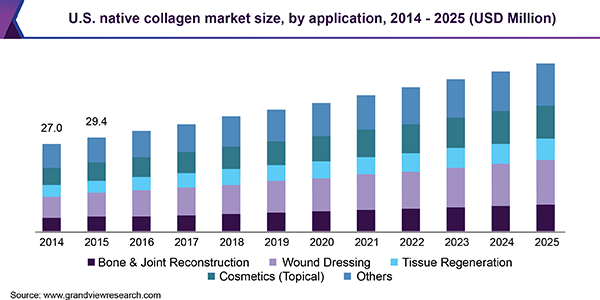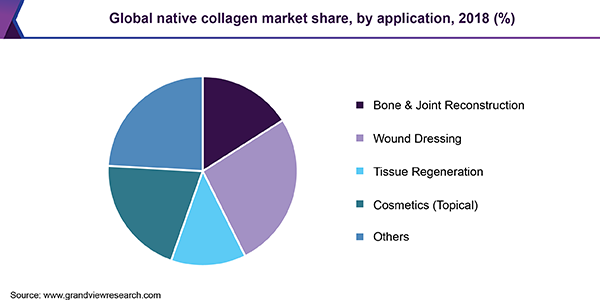- Home
- »
- Food Additives & Nutricosmetics
- »
-
Native Collagen Market Size, Share, Industry Analysis Report, 2025GVR Report cover
![Native Collagen Market Size, Share & Trends Report]()
Native Collagen Market Size, Share & Trends Analysis By Source (Bovine, Porcine, Poultry, Marine), By Application (Bone & Joint Reconstruction, Wound Dressing, Cosmetics (Topical)), And Segment Forecasts, 2019 - 2025
- Report ID: GVR-4-68038-089-7
- Number of Report Pages: 114
- Format: PDF, Horizon Databook
- Historical Range: 2014 - 2017
- Forecast Period: 2019 - 2025
- Industry: Specialty & Chemicals
Industry Insights
The global native collagen market size was valued at USD 160.5 million in 2018 and is estimated to exhibit a CAGR of 5.4% from 2019 to 2025. Rising adoption of the product in several applications, such as cosmetics and healthcare and pharmaceuticals is anticipated to drive the growth. Rising awareness regarding medical application for wound healing and treatment of rheumatoid arthritis and osteoarthritis is anticipated to further drive the product demand.
Native collagen is extracted from the cartilages and bones of bovine, poultry, porcine, and marine species. It is insoluble and is characterized by less probability of direct consumption as well as inclusion in food and beverage products. This raw and unprocessed form of collagen finds application in bone and joint reconstruction, wound healing, tissue generation, and in the formulation of topical cosmetic products.

According to the Centers for Disease Control and Prevention (CDC), National Center for Chronic Disease Prevention and Health Promotion (NCCDPHP), 67 million of the total U.S. population is likely to suffer from arthritis by 2025. Increasing aging population along with high inclination of consumers toward nutraceutical supplements is anticipated to boost the market growth in the forthcoming years. Sigma-Aldrich and TSI GROUP are the prominent manufacturers and suppliers of native collagen in the country. Products offered by these companies are clinically proven and halal certified. Increasing demand for these products for the treatment of joint health problems is anticipated to fuel the overall demand from the U.S.
Native collagen is processed in order to explore its nutritive value and its bioavailability since it is hard to digest. The process of transforming the product into its processed form is known as hydrolyzation, which involves breaking down the molecular bonds present between the individual strands of undenatured collagen into small peptides. These peptides are then absorbed and properly digested by the body. The processed products are used in the formulation of several food and beverage items and dietary supplements that contribute to the health of joints, bones, and skin. Rising acceptance of processed products is projected to hamper the native collagen market growth over the forecast period.
Native collagen is used in the formulation of different types of topical cosmetic products, especially skincare and haircare products. It is the highly pure form and is thus used in anti-aging products to prolong the aging process and to ensure wrinkle-free skin. The product is specifically used to promote lubrication for cartilages and joints. Growing awareness regarding the advantages of this product for healing wounds and providing relief against rheumatoid arthritis and osteoarthritis in medical sector, is anticipated to drive the demand in near future.
Source Insights
Native collagen can be extracted from tendons, ligaments, dermis, and blood vessels of bovine animals. Bovine-based product is used in various cosmetic formulations and medical applications. It is widely utilized as a thin layer on tissue-culture as well as in wound dressings, dermal fillers, and scaffolds. It is also used in wound dressings since it exhibits anti-inflammatory, anti-fibrotic, anti-infective, and analgesic properties and promotes angiogenesis, which ultimately helps in faster wound healing.
Native collagen can be derived from various other sources including chicken and avian birds. Chicken is one of the major sources of native collagen due to its high protein content. The growth of the segment can be attributed to the rising demand for poultry-based products in nutraceutical applications, including bone and joint health supplements. Poultry-based native collagen supplements are used for treating rheumatoid arthritis and osteoarthritis. They also assist in reducing joint inflammation and cartilage degradation, thus improving bone and joint health.
Native marine collagen is used for developing biomedical materials for bone and tissue engineering. When sourced from salmon and tilapia species, it is used for developing scaffolds that are further employed for bone and oral mucosa regeneration activities. When derived from jellyfish and marine gastropods, it is used in scaffolds for cartilage repair. Cultural practices and religious beliefs of consumers have restrained the use of bovine and porcine derived products in several Middle Eastern and Asian countries. As a result, manufacturers are increasingly focusing on the marine sources of native collagen. These factors are expected to drive the demand for native marine collagen over the forecast period.
Application Insights
Native collagen wound dressings are used to treat chronic wounds as they inhibit the action of metalloproteinase. They also promote wound healing through the discharge of newly formed fibers, thus creating a favorable environment for wound healing. Bleeding may occur in cutaneous lesions due to the shearing of the gauze dressings. Treating such wounds with native collagen sheets encourages angiogenesis and also aids the body’s repair mechanisms.

Native collagen-based haircare products help reduce hair thinning and offers protection against sun damage. In addition, it promotes hair growth and boosts scalp hydration. The native collagen market players engage in continuous R&D activities to develop innovative products. They are also increasingly incorporating marine-based native collagen to boost product reach. For instance, COBIOSA produces native marine collagen for hair and skincare applications.
Native collagen is used in bone grafting to aid bone defect reconstruction. It is used as a bone graft material for the treatment of acquired and hereditary defects either singularly or in combination with hydroxyapatite. It enhances osteogenesis by removing fast-growing epithelial tissue from the treatment site. Furthermore, it is used as a medium to transport bone-inducing proteins and is also employed as a bone substitute due to its osteoinductive activity.
Regional Insights
The Europe market for native collagen is anticipated to be driven by the growth of several end-use industries, such as cosmetic and healthcare. Undenatured type II collagen, a product by Lonza, has been studied clinically in healthy adults in the region and has shown to help improve joint flexibility, comfort, and mobility in people with osteoarthritis. Benefits such as improved joint function and reduced joint pain and inflammation associated with native collagen have bolstered its demand in applications such as bone and joint health, tissue regeneration, and wound dressing.
High prevalence of osteoarthritis, as well as several issues related to joint health among individuals in developing economies, such as China and India owing to the presence of aging population, is expected to create growth opportunities for the market in near future. China prominently engages in animal farming, which provides access to inexpensive raw materials for manufacturing native collagen. In China, bovine-sourced native collagen is mostly used in pharmaceutical sector, whereas bovine and porcine sourced products finds application in cosmetic sector.
North America emerged as the prominent regional market in 2018, attributed to the growth of nutraceutical, pharmaceutical, cosmetic, and other such end-use industries. In North America, bovine-sourced native collagen is preferred for pharmaceutical applications owing to the easy availability of raw material at a low cost. Factors, such as the high prevalence of osteoarthritis and increasing utilization of the product in bone and joint restructuring, tissue regeneration, wound dressing, and treating rheumatoid arthritis are anticipated to drive regional growth.
Native Collagen Market Share Insights
A majority of the market players are forward-integrated across the value chain and also offer extracted products. For instance, Symatese is a prominent producer and is also engaged in the production of different forms of collagen. On the other hand, Vetoquinol S.A. is characterized by forward integration and is engaged in manufacturing joint health supplements using undenatured type II native collagen.
Manufacturing companies require extensive capital investment due to the presence of various regulations pertaining to the labeling and testing of products. This also discourages new players from entering the market. A majority of manufacturers are investing heavily in R&D activities to meet regulatory norms, specifications, and guidelines. Several native collagen suppliers are focusing on dealing with more than one supplier owing to price competitiveness in the market due to the niche nature of the product.
Report Scope
Attribute
Details
Base Year for Estimation
2018
Actual Estimates/Historical Data
2014 - 2017
Forecast period
2019 - 2025
Market Representation
Volume in Tons, Revenue in USD Million & CAGR from 2019 to 2025
Regional scope
North America, Europe, Asia Pacific, Central & South America, Middle Easy & Africa
Country scope
U.S., Canada, Germany, U.K., France, Italy, China, India, Japan, South Korea, Brazil, Argentina, Mexico, South Africa, Saudi Arabia
Report coverage
Revenue forecast, company share, competitive landscape, growth factors, and trends
15% Free customization scope (equivalent to 5 analysts working days)
If you need specific information, which is not currently within the scope of the report, we will provide it to you as a part of customization
Segments Covered in the ReportThis report forecasts revenue and volume growth at the global, regional, and country levels and provides an analysis of the latest industry trends in each of the sub-segments from 2014 to 2025. For the purpose of this study, Grand View Research has segmented the global native collagen market report on the basis of source, application, and region:
-
Source Outlook (Volume, Tons; Revenue, USD Million, 2014 - 2025)
-
Bovine
-
Porcine
-
Poultry
-
Marine
-
Others
-
-
Application Outlook (Volume, Tons; Revenue, USD Million, 2014 - 2025)
-
Bone & Joint Reconstruction
-
Wound Dressing
-
Tissue Regeneration
-
Cosmetics (Topical)
-
Others
-
-
Regional Outlook (Volume, Tons; Revenue, USD Million, 2014 - 2025)
-
North America
-
The U.S.
-
Canada
-
-
Europe
-
Germany
-
The U.K.
-
France
-
Italy
-
-
Asia Pacific
-
China
-
India
-
Japan
-
South Korea
-
-
Central & South America
-
Brazil
-
Argentina
-
Mexico
-
-
Middle East & Africa
-
South Africa
-
Saudi Arabia
-
-
Share this report with your colleague or friend.
![gvr icn]()
NEED A CUSTOM REPORT?
We can customize every report - free of charge - including purchasing stand-alone sections or country-level reports, as well as offer affordable discounts for start-ups & universities. Contact us now
![Certified Icon]()
We are GDPR and CCPA compliant! Your transaction & personal information is safe and secure. For more details, please read our privacy policy.
We are committed towards customer satisfaction, and quality service.
"The quality of research they have done for us has been excellent."





